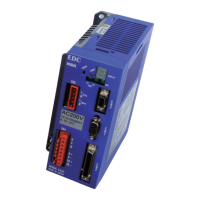— 3-3 —
3.2.1.3. Coupling Load to Motor
!
Warning : Fix the load using the bolt-holes of the rotor. Take a great care for play
between the rotor and the load.
◊ The following are the maximum tightening torque of fixing bolts
(1) PS 1 Motor: 3.4 N•m (M4 bolt)
(2) PS 3 Motor: 7.8 N•m (M6 bolt)
!
Caution : When you use pin holes on the rotor (output axis) of PS3 Motor, follow
the notes below.
◊ Set the tolerance quality of locating pin diameter for running fit.
◊ Do not apply excessive force or shock to the Motor when inserting a locating pin.
◊ The function of the pinholes is simply to adjust the position of a mating part with the
Motor. Do not use the pinholes to lock the mating part (load).
3.2.1.4. Confirmation of Use Conditions
The load moment of inertia is generally much bigger than the rotor moment of inertia in the
Megatorque Motor System. The table below shows the approximate inertia capacity of each
Motor size.
Table 3-1: Maximum load inertia of Megatorque Motor
Rotor inertia
[kg•m
2
]
Maximum load inertia
[kg•m
2
]
PS1006
0.0024 0.23
PS1012
0.0031 0.30
PS1018
0.0038 0.37
PS3015
0.011 1.0
PS3030
0.014 1.3
PS3060
0.019 1.8
PS3090
0.024 2.3
!
Warning : Check if the use conditions exceed the allowable axial load and the
allowable moment load of the Motor.
◊ Refer to “2.5. Motor Specifications” for the allowable axial load, allowable radial load
and the allowable moment load.
3.2.1.5. Dummy Inertia
For the full use of the benefits of the direct drive motor system, it is essential to maximize the
resonance frequency of the whole mechanism by increasing the rigidity of the load, as well as
securely fastening the Motor to a highly rigid mechanical system. Therefore, adding some
dummy load to the rotor directly may help in the following cases.
(1) A key is used to fix the load to the rotor because the load cannot be directly attached to
the rotor.
(2) The load is directly fixed to the rotor. However, vibration occurs due to torsional
deflection on the rotary axis of the load.
(3) Inertia of the whole mechanism is very low when a thin shaft such as a ball screw shaft
is attached.
(4) There exists play because a sprocket chain or a gear train is used.

